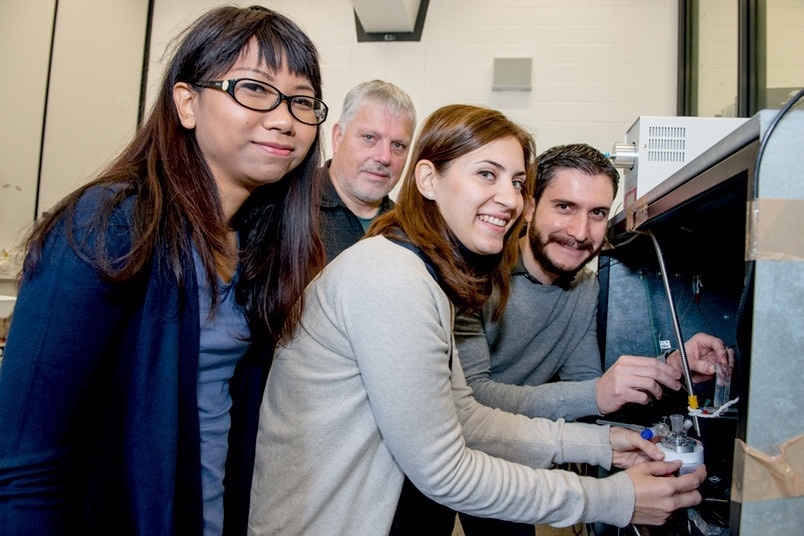Nov 16 2016
 The Bochum-based team: Piyanut Pinyou, Wolfgang Schuhmann, Sabine Alsaoub and Felipe Conzuelo (from left) (© RUB, Marquard)
The Bochum-based team: Piyanut Pinyou, Wolfgang Schuhmann, Sabine Alsaoub and Felipe Conzuelo (from left) (© RUB, Marquard)
Efficient production and storage of energy - for example, for implanted medical systems - is a major challenge for today’s society. Now, scientists have developed a new biocatalyst-polymer system that could perform both tasks at once. This system is a hybrid of a fuel cell and capacitor on a biocatalytic basis.
With the help of enzymatic processes, the new hybrid system called biosupercapacitor generates and stores energy in an efficiently. The trick is enzymes are embedded in a stable polymer gel, which is capable of storing a large amount of energy.
The researchers at the Swedish Malmö University and the Ruhr-Universität Bochum have reported their development in the “Angewandte Chemie” journal.
Societal Challenge
One of the major challenges for today’s society is producing and saving energy with as little loss as possible. The process of producing and storing energy usually occurs in different systems, but this method is not efficient. However, this is different in the novel biosupercapacitor, which integrates both processes.
Such a technology could, for instance, be interesting for miniaturized devices, which should even supply themselves with energy wirelessly. This is particularly important for implantable miniaturized sensors.
Dr Wolfgang Schuhmann, Professor, Bochum Institute for Analytical Chemistry
He was involved in this breakthrough development with his colleagues, Dr Piyanut Pinyou, Dr Felipe Conzuelo, and Sabine Alsaoub.
Enzymes at Both Electrodes
With the help of an enzyme, the biosupercapacitor is able to burn glucose as a fuel at one electrode, while an enzyme transforms oxygen into water at the other electrode. In order to establish an electrical contact with the electrodes, both enzymes should be integrated in an electron-conducting gel. For the first time ever, the researchers used the same gel, also known as redox polymer, for both electrodes.
When the energy is being charged and stored, the redox polymer at one electrode emits electrons and is therefore positively charged. The same polymer absorbs the electrons at the other electrode and is therefore negatively charged.
During the discharging process, the charges equal out and a current flows.
Dr Wolfgang Schuhmann, Professor, Bochum Institute for Analytical Chemistry
High Capacity
The system arranged in this way was found to be stable in all the tests conducted by the research team, and it can act as a permanent source of energy. As it also has a high capacity and a low weight, it can hold a large charge.
“We see this work as a starting point for future strategies in the development of new, highly functional and also affordable electrical sources of energy on bioelectrochemical basis,” summarize the authors.
The European Commission (PEOPLE-2013-ITN-607793), the Swedish Research Council (621-2013-6006), the Russian Science Foundation (14-14-00530), the German Research Foundation as part of the cluster of excellence Resolv (EXC 1069) as well as the German-Israeli project cooperation as part of the project “Nanoengineered optoelectronics with biomaterials and bioinspired assemblies” supported the work.